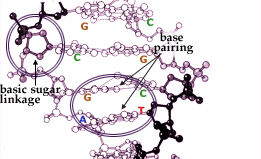|
About DNADNA stands for deoxyribonucleic acid. It consists of two associated polynucleotide strands forming a double helix structure. The helix makes a complete turn avery 3.4 nm and there are about 10.5 basepairs per turn. On the outside of the double helix the spaces between the intertwined strands form two helical grooves of different widths described as the major groove and the minor groove. The sequential arrangement of base pairs in a DNA molecule can be sensed via the major groove and the minor groove as a surface pattern of hydrogen donors, hydrogen acceptors and hydrophobic patches. DNA-binding proteins that form DNA sequence specific complexes usually recognize their cognate DNA segment via a DNA-binding domain which has a surface pattern complementory to the pattern of the major and/or minor groove of that particular DNA segment. DNA contains a coded representation of all the proteins in the cell. Other molecules such as sugars and fats are synthesised by proteins (enzymes) so their structures are indirectly coded by DNA. DNA also contains all the information required to make the correct amount of protein at the correct time, thus controlling all biological processes from those of day to day life such as metabolic activity to those of embryogenesis and fetal development. The human genome contains 3x109 base pairs of DNA divided into 23 chromosomes which if linked together would form a thread of 1 meter with a diameter of 2 nm. This DNA codes for about 105 different proteins. In fact only about 2-4 % of the total coding capacity in the human DNA is used for coding of different genes, the rest of it probably has other more structural and organizational functions. |

